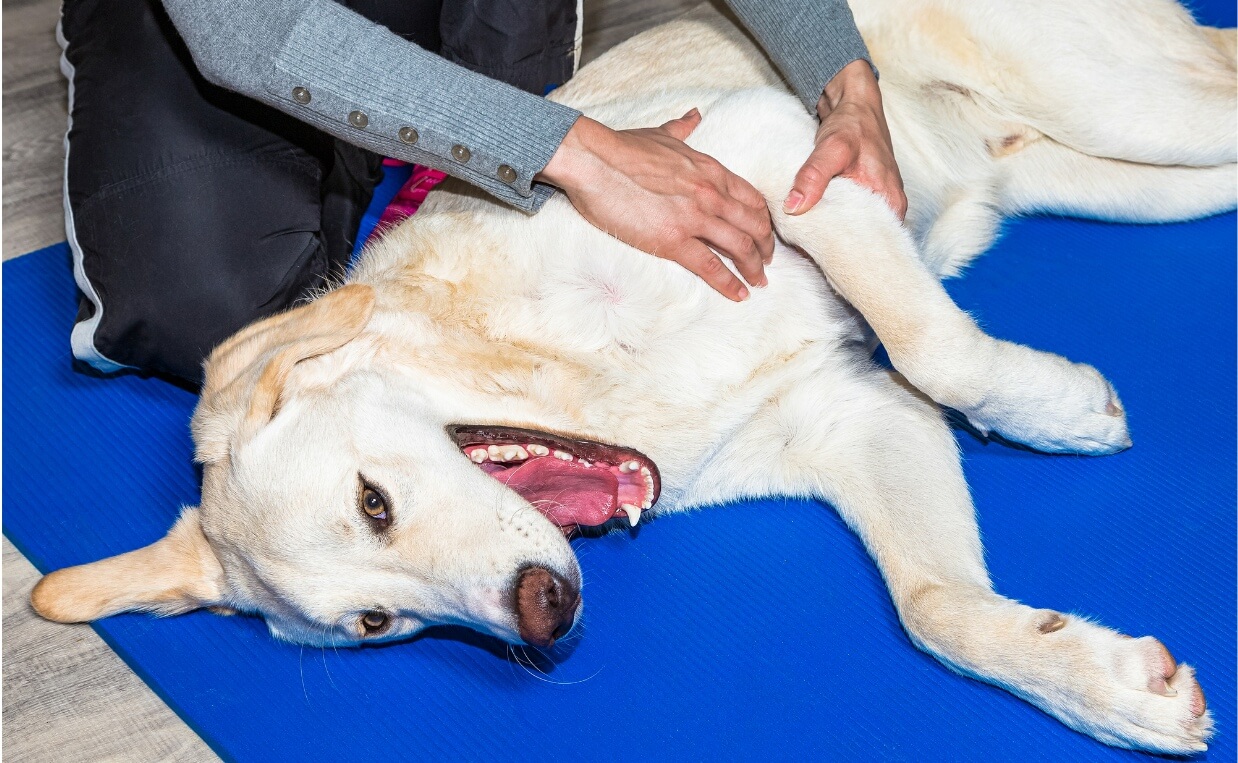
Dogs are prone to inflammation, just like humans. This can be caused by a variety of things, such as allergies, injuries, and infections. When your dog is experiencing inflammation, it can be very uncomfortable and even painful.
What is Inflammation in Dogs?
Inflammation is a common physical response, usually to injury or illness. It’s the body’s way of protecting and healing itself by dilating blood vessels and sending white blood cells to the affected area. It’s a crucial immune response that helps keep us and our dogs alive – but it can sometimes get out of control.
Inflammation has five characteristics: redness, heat, swelling, pain, and loss of function. Redness and heat result from increased blood flow to the area while swelling occurs from the accumulation of fluid. Inflammation is painful due to a variety of factors including chemicals released by the body. The cumulative result of the first four characteristics is a loss or reduction of function such as limping or diarrhea.
Inflammation is common in dogs and although the process is similar throughout the body, we give it different names based on where it’s happening and what kind of loss of function it causes.
Diseases of inflammation end in -itis. For example, otitis is inflammation of the ear and colitis is inflammation of the colon. Sometimes inflammation is due to a pathogen (bacteria, virus, or parasite), such as whipworm colitis, but stress colitis causes the same set of symptoms without any foreign invader.
Just like humans, dogs experience inflammation in a variety of ways. The most common types of inflammation are inflammation of:
- Joints
- Skin
- Internal tissues.

Inflammation of the Joints
Best known as arthritis, inflammation of the joints in dogs – and humans – can be quite painful. The most common form of arthritis in dogs is canine osteoarthritis. Canine osteoarthritis is caused when the smooth cartilage that cushions the bones of the joint wears away, causing bone-on-bone friction. The end result is pain and limited mobility. Dogs may have problems moving, standing up, and may pull away if the affected area is touched.
Arthritis may also have noticeable swelling and an affected dog may habitually lick certain joints in an attempt to relieve the pain.
Septic arthritis is another form of inflammation of the joints. It occurs when bacteria or another infectious agent is introduced into the joints, leading to painful inflammation. The signs of septic arthritis include heat, swelling and pain. There will typically be decreased range of motion in the affected joints, as well as fever, lethargy and loss of appetite. Any trauma that penetrates the joint, or a surgery, can result in septic arthritis.
Inflammation of the Skin
Canine skin inflammation in dogs is called dermatitis. Dermatitis doesn’t define one specific condition – it’s a general term used to describe any sort of skin inflammation. There are many ways in which a dog’s skin may become inflamed, including infections, illness, and allergic reactions to flea bites or food.
Dermatitis manifests as itchy skin rashes and bald spots. Dogs will try to relieve skin inflammation by scratching, licking, and excessive grooming, resulting in secondary skin infections, fur loss, scabs, and skin redness.
Yeast dermatitis is an extremely common skin disease in dogs. Clinical signs include itchiness, redness, scaly or crusty skin, and foul odor. Yeast normally live on the skin of dogs and when there is a change in the health of the dog yeast are more likely to multiply and a yeast infection results.

Inflammation of Internal Tissue
Inflammation of internal tissue is characterized by redness, swelling, heat, pain, and loss of tissue function. Inflammation of internal tissues results from immune, vascular and inflammatory cell responses to infection or injury.
-
Eye inflammation
A dog’s eyes can become inflamed for a variety of reasons; some of the conditions are easy to fix and some are very serious.
- Conjuctivitis is where the mucus of the eye become inflamed and itchy
- Glaucoma is a much more serious condition caused by increased pressure within the eye itself
- Allergies cause itchy, watery eyes
- Foreign objects in the eye, even eyelashes, cause the eye to be irritated
- Scratched cornea can develop into a more serious condition, such as an ulcer
- Entropion is when the eyelashes are turned inward instead of outward, causing the eye to tear, become irritated, and ultimately infected, if not treated
- Uveitis is an inflammation of one or more of the structures making up the uvea. It can be very painful and lead to blindness. It may be a primary condition or a sign of an underlying condition.
-
Otitis
Otitis is an ear infection in dogs. There are two types – otitis interna and otitis externa. Otitis interna can cause significant symptoms such as alteration in balance, and reduced hearing. Otitis externa is inflammation of the outer ear. This is extremely common in dogs. Ear infections are painful. Antibiotic ear drops are generally used to treat canine ear infections.

-
Steatitis
Dogs can experience inflammation in their fatty tissues, known as steatitis. This condition can be difficult to recognize, but most commonly presents itself as lumps under the skin. If untreated, steatitis can lead to a decreased appetite, lethargy, fever, and physical pain when touched. This condition can occur on its own or in conjunction with more serious health conditions like cancer, blood disease, immune-related diseases, and injury.
-
Entertitis
The most hidden form of inflammation in dogs is in the small intestines – a condition called entertitis, caused by infection, parasites, or allergies. Even though the condition may be obscured, the symptoms of entertitis are quite visible, and include diarrhea or other abnormal stool, vomiting, depression, fever, abdominal pain, and decreased appetite.
-
Peritonitis
Peritonitis in dogs is a condition where the peritoneum, which is the thin, watery membrane that lines the abdominal cavity, become inflamed. This happens with the abdominal cavity suffers injury, which can be caused by physical trauma, disease, a stomach ulcer, or other problems.
Common symptoms of peritonitis include fever, vomiting, diarrhea, black stools, pale gums, anorexia, lethargy, weakness, and abdominal pain. Dogs with peritonitis will often take unusual positions to try to relieve the pain and may have swelling in the abdomen.
Peritonitis is a very serious condition and can be life-threatening. If your dog exhibits any of these symptoms it is imperative you get your dog to a veterinarian immediately for proper diagnosis and treatment.

-
Pancreatitis
When the pancreas becomes inflamed, the condition is called pancreatitis. Pancreatitis is a common condition in dogs. Pancreatitis may be acute or chronic.
The most common symptoms of pancreatitis include nausea, vomiting, fever, lethargy, abdominal pain, diarrhea, and decreased appetite. During an attack, dogs may take a “praying position”, with their rear end up in the air while their front legs and head are lowered onto the floor. If the attack is severe, acute shock, severe depression, and even death may occur.
Learn more about pancreatitis here: Pancreatitis in Dogs – Symptoms, Causes and Treatment
-
Cystitis
Cystitis means inflammation of the bladder. The most common cause of cystitis in dogs is an infection caused by bacteria. The most common clinical sign is hematuria or blood in the urine.
-
Colitis
As mentioned earlier in this article, colitis is inflammation of the colon. Frequent diarrhea and loose stools are common symptoms of colitis. Stress colitis is one of the leading causes of large bowel diarrhea in dogs. Whatever the cause, the inflammation in the colon results in reduced water absorption and decreased ability to store feces in the colon. This causes the classic symptom of frequent small amounts of diarrhea, often with mucus or blood.

-
Gingivitis and stomatitis
Gingivitis refers to inflammation of the gums. Stomatitis may involve gums, tongue, inner surfaces of the lips, and/or the floor and roof of the mouth. Gingivitis may be caused by a bacterial infection from plaque bacteria on the teeth and is usually associated with poor oral hygiene and can lead to more severe periodontal disease.
Learn more here: Does Your Dog Have Hidden Dental Disease?
-
Chronic obstructive pulmonary disease (chronic bronchitis)
Chronic obstructive pulmonary disease or chronic bronchitis is a slowly progressing inflammatory condition of the lower airways. It most often affects small or toy breeds from middle-aged and senior dogs. The most common symptom is a dry cough. Exercise intolerance , collapsing, wheezing, or noisy breathing may develop as the condition worsens. This condition can be managed with treatment.
-
Lick granuloma
Lick granuloma occurs when a dog obsessively licks at an area on the lower limb, usually the wrist or carpal joint of the front limb. This condition is thought to be both physical and psychological in nature.
-
Bacterial pneumonia and bronchopneumonia
Bacterial pneumonia is an inflammation of the lungs, usually caused by a bacterial or viral infection, but can be caused by inhalation of an irritant. Typical signs of bacterial pneumonia include fever, difficulty breathing, lethargy, and coughing.

-
Meningitis
Meningitis refers to inflammation of the membranes that cover the brain and spinal cord. Causes include bacterial infection, viral infection, fungal infection, protozoal infection, aberrant parasite migration, or immune-mediated disease. Treatment and prognosis vary, depending on the underlying cause.
-
Pemphigus
Pemphigus is an autoimmune skin disease, in which the body’s immune system attacks the connections between its own skin cells. Treatment require suppression of the immune system and prognosis varies depending on the type.
-
Panosteitis
Panosteitis is a painful of the outer surface or shaft of one or more long bones of the legs. It is sometimes called growing pains. Panosteitis is a condition that affects young, rapidly growing dogs. Panosteitis will be suspected if the patient shows pain when pressure is applied to the affected bones. The diagnosis is confirmed by x-rays, which usually show a characteristic increase in the density of the affected bones.
-
Tonsillitis
The tonsils are similar to lymph nodes, and the role of both of these structures to fight infection. There is a pair of tonsils located in small pouches at the back of the throat that enlarge during infection or inflammation. Tonsillitis usually occurs as a result of another disease that affects the mouth or throat. If an underlying source of the infection can be found, it must be treated.

-
Pododermatitis
Pododermatitis is a term used to describe inflammation of the feet or paws. It can be caused by many disorders such as infections, allergies, hormonal disorders, immune-mediated diseases, tumors or cancers, and environmental contaminants.
While these are the most common types of inflammation in dogs; there are many other inflammatory conditions not covered here.
Acute Versus Chronic Inflammation
When it comes to defining specific types of inflammation it’s also important to distinguish between acute and chronic inflammation.
Acute inflammation occurs as a near-immediate response to a specific injury. For instance, when you break a bone, there’s swelling, redness, and heat as the body tires to prevent infection and help repair damaged tissues.
Chronic inflammation is the more potentially insidious form. It’s a longer-term, low-level reaction that may affect the entire body if untreated and can ultimately even damage DNA. Although chronic inflammation is not as well understood, it results in damage to the body’s cells and can increase the risk of illnesses like heart disease and cancer.
How to Potentially Reduce Canine Inflammation
Helping your dog maintain a healthy lifestyle, receive proper exercise, keep stress low, receive good nutrition and maintain a fit weight are all ways to reduce inflammation. Once your dog is diagnosed with inflammation, steroids may be prescribed to reduce inflammation but cannot be taken long-term. Non-steroidal anti-inflammatories (NSAIDs), while safer, are potentially less effects and may have long-term side effect concerns.
Pros and Cons of Non-Steroidal Anti-Inflammatory for Dogs (NSAIDS)
Common non-steroidal anti-inflammatory drugs for dogs are Carprofen, Deracoxib, Firocxib, and Meloxicam. Although NSAIDs can be effective in treating inflammation in dogs, they do have serious side effects. NSAIDS can damage the joints and the liver, which can result in ulcers. If you do decide to put your dog on NSAIDs, it is imperative you monitor your dog’s liver enzyme levels.
If you choose to use NSAIDs, it’s crucial to be aware certain other medications cannot be mixed with them. If you take your dog to an emergency or back up veterinarian, be sure he or she is aware your dog is on NSAIDs before prescribing a medication.

Natural Anti-Inflammatory Remedies for Dogs
Since there can be significant negative side effects to NSAIDs, some dog owners look into natural anti-inflammatory options for dog. Before giving your dog alternatives, be sure to talk with your vet to learn more about the various natural anti-inflammatory medications and herbs for dogs.
Examples of a natural anti-inflammatory for your dog include:
-
CBD
Don’t be afraid of CBD! It’s actually a very effective anti-inflammatory. When choosing CBD oil, be sure to p ick up the hemp-derived product as it contains no THC, which causes the psycho-active ingredients associated with marijuana and is toxic to dogs. CBD acts as a relaxant, allowing your dog to feel relief from pain during times of inflammation. Although not a treatment for the cause of your dog’s condition, it’s a great way to manage their pain and help them relax.
-
Turmeric
This common spice is a miracle ingredient when it comes to inflammation. The yellow fragrant spice has been used as a natural anti-inflammatory for generations. Research shows curcumin, the active ingredient in turmeric, works just as well as a number of pharmaceutical anti-inflammatories. Add a sprinkle to your dog’s tea or make a paste from warm water to treat your pup.
-
Ginger
Another plant root proven to effectively treat inflammation in ginger. This zingy spice is particularly effective in the treatment of digestive inflammation. You’ll find ginger reduces nausea, vomiting and stomach pain in your dog.

-
Licorice Root
The plant kingdom really is full of anti-inflammatory wonders. Licorice root contains glycyrrhizin, which is a natural corticosteroid. This root works well alongside your vet’s treatment plan for inflammation, be it joint, skin or digestive issues.
-
Arnica
This plant can be used to externally to treat skin, muscle and joint inflammation. Make sure your dog doesn’t consume arnica as it is only for external use.
If you’re in doubt about whether a natural remedy will benefit your dog, be sure to check with your veterinarian.
Inflammation is a common ailment in dogs but luckily it is easy to spot and there are many ways to reduce it.
Is your dog suffering from inflammation? What treatments are helping him or her? Please share in the comments below…

 Top 10 Health Concerns for Large Breed Dogs
Top 10 Health Concerns for Large Breed Dogs FDA Warns Bone Treats May Be Deadly for Your Dog
FDA Warns Bone Treats May Be Deadly for Your Dog What Every Dog Owner Should Know About Skin Lumps and Bumps in Dogs
What Every Dog Owner Should Know About Skin Lumps and Bumps in Dogs A Guide to Laser Therapy for Dogs
A Guide to Laser Therapy for Dogs Signs, Causes and Treatments for Canine Papillomas (Warts)
Signs, Causes and Treatments for Canine Papillomas (Warts)






Leave a Reply